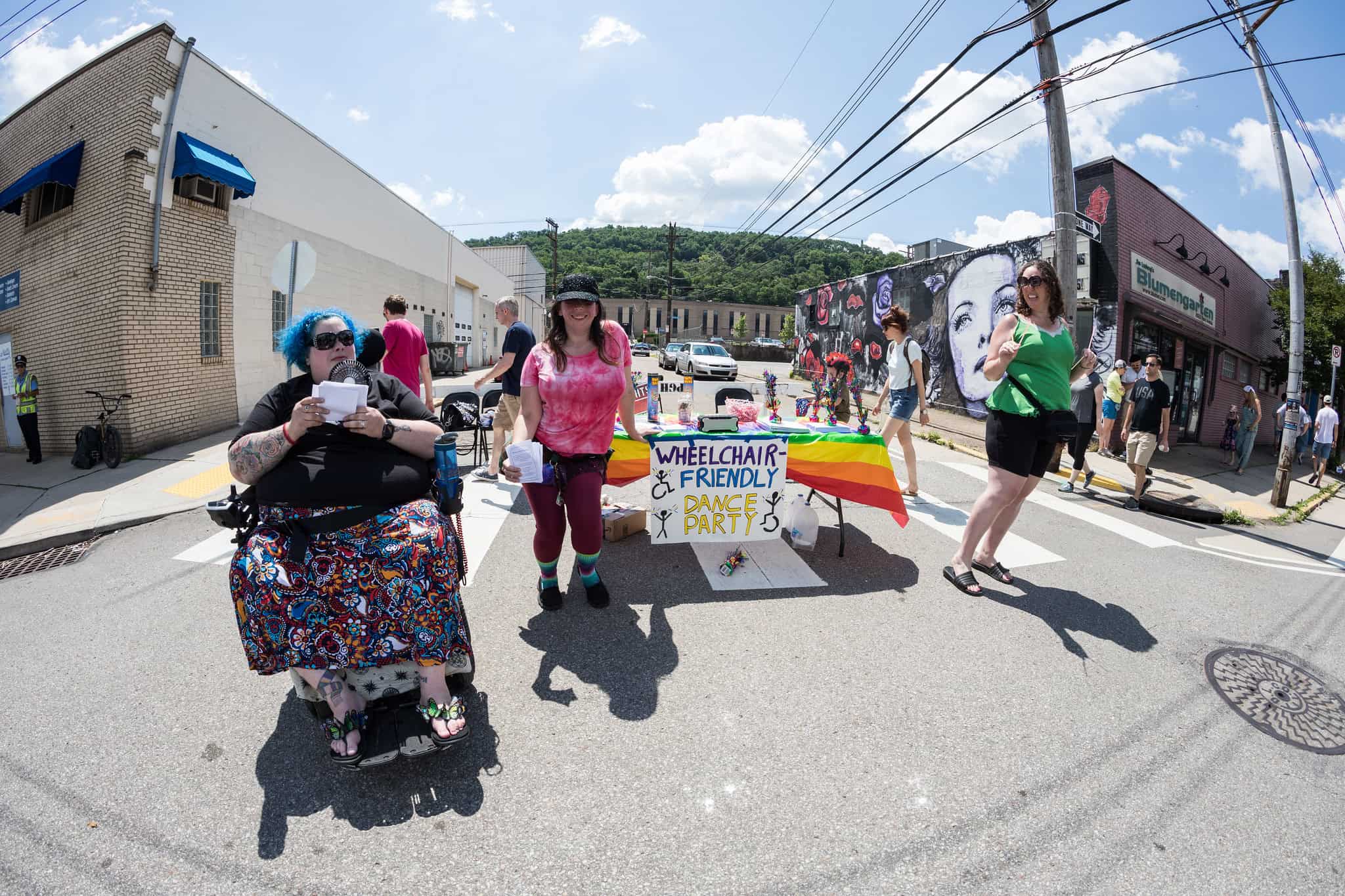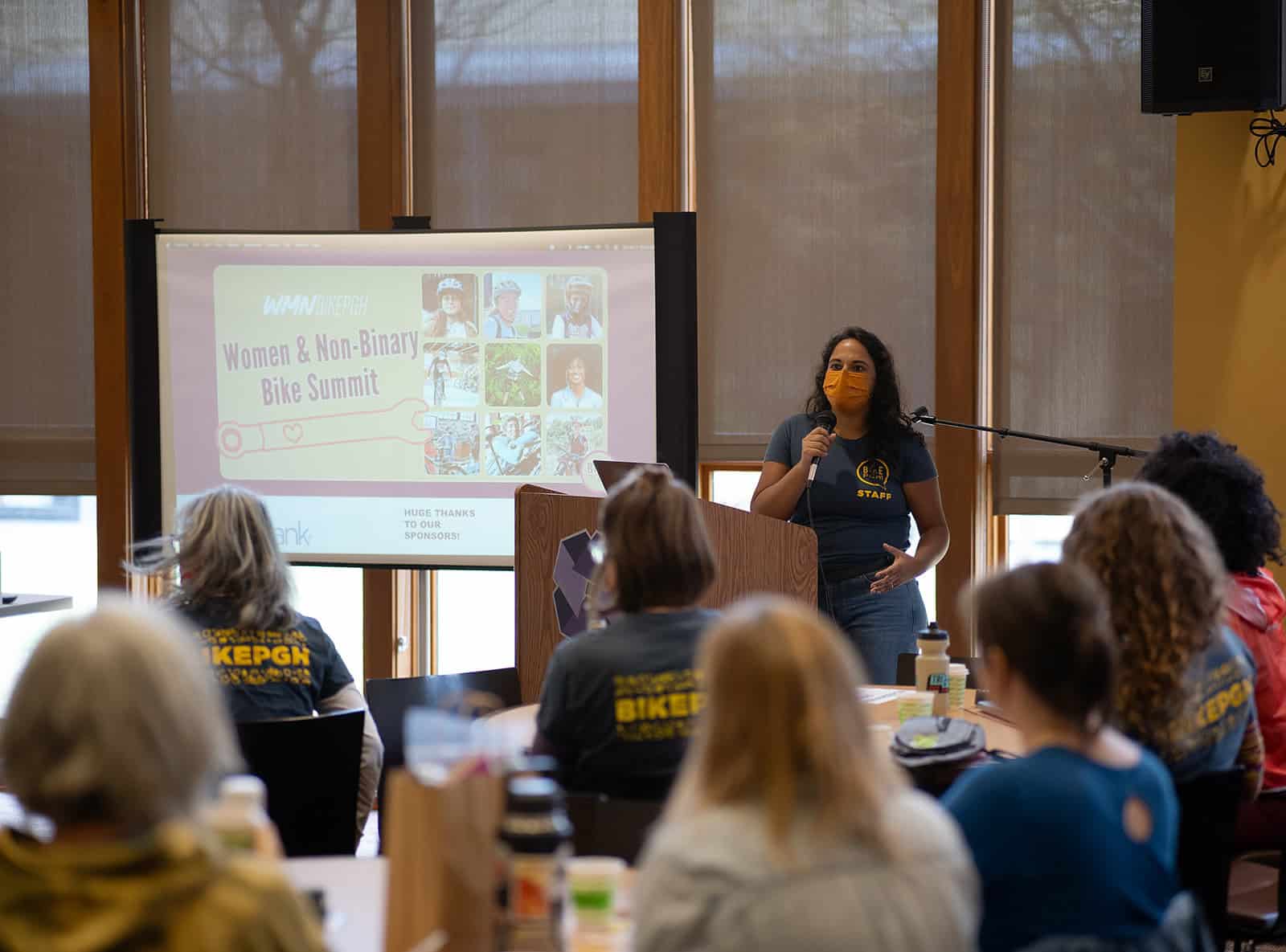by BikePGH Staff Contributor – Seth Bush

Terms like diversity, equity, and inclusion are used a lot by organizations and teams seeking to be a benefit to society. At BikePGH we use the acronym EDI&A to encapsulate our commitment to equity, diversity, inclusion, and accessibility. Some organizations throw in others like humility, dignity, solidarity, belonging, justice, or go with only one or a couple of terms. I’ll admit, sometimes it can end up feeling like alphabet soup!
No approach is necessarily better than the other because, at the end of the day, actions and results speak louder than words. The true value of these frameworks lies in how an organization demonstrates their commitment to creating a world where historical and present-day harms of racism and exclusion can be healed to create communities where everyone can thrive. At BikePGH, EDI&A works well for our mission that includes community building, education, and advocacy. We have clear definitions for each and a strategic plan that uses those definitions to guide all of our programming (which perhaps we’ll write about in a future blog post).
Now, though, I want to share a slightly different framework that I draw on in my work as BikePGH’s Advocacy Manager and in my community organizing work where I live in Swissvale. A lot of the words are the same, but it puts “Justice” up front to create the acronym J.E.D.I.: Justice, Equity, Diversity, and Inclusion. Yes, the nerds among our readers have permission to chuckle and make lightsaber noises. We’re never going to heal centuries of oppression together without some joy!
I learned this framework, its definitions, and practices from one of my mentors Mazin Jamal who founded the organization Holistic Underground where I was trained as a Certified DEI / J.E.D.I. Practitioner in 2022. Wherever you see quotes, those are his words and the definitions and practices are from the PurposePlace Methodology he developed.
I’m going to break down the definitions of each term and offer some practices in hopes that you will try them in your own advocacy for complete streets or whatever community benefit work you might be involved with. And if you’re not yet involved in making our streets safer for everyone who walks, bikes, and rolls, come to one of our Intro to Bike/Ped Advocacy Calls!
Okay, let’s break it down…
Justice
Definition: A state of integrity and wholeness achieved through healing or transformation.
“When we practice justice, people can trust that their lives, safety, and well-being are valued and cared for in a team, community, or society.”
When we talk about making our streets “complete”, we’re talking about changing their current, often car-centric, design to work better for all users including people who walk, bike, take the bus, and use mobility aids. We’re talking about changing our streets to make them safe and accessible for everyone to get to everyday destinations without worrying that they might be injured or worse along the way by the driver of a motor vehicle. And, unfortunately, we’re seeing a frightening increase in traffic crashes that disproportionately impact Black people and people of color because so many of our streets are “dangerous by design”. A recent report by that name showed that, “People of Color, particularly Native and Black Americans, are more likely to die while walking than any other race or ethnic group.” If our communities value safety, accessibility, and caring for our neighbors like I believe most of us do, then it is clear that our streets are not places of integrity with those values. Healing and transformation is needed.
However, many communities in Pittsburgh that stand to benefit from infrastructure investment to transform streets from being dangerous for people to places where people can thrive are rightfully skeptical of change because many other initiatives for “transformation” in the past have led to gentrification and neighbors being excluded from decisions that affect their own future. So, as advocates we have more work to do than simply saying, “a bike lane would be great here!”, especially when we’re working in communities where we might travel but don’t live.
Here is a step-by-step way to start practicing the Justice principle to achieve transformation with integrity:
- Work to understand and acknowledge the experience of people impacted by the change, including histories of harm, conflict, and exclusion that might influence their perception of new ideas. Build relationships with people! This is important for any organizing endeavor.
- Acknowledge where you are “response-able” (Mazin taught me this riff on the word “responsible”). In what ways are you or your group able to help address the wrongs of the past or at least not repeat the same mistakes? You can’t heal every historical harm or even most harms, but you likely have some agency to facilitate repair.
- Create a vision for restored or increased integrity and wholeness, and do it in collaboration with the people impacted. What would thriving, complete streets designed for justice look like?
- Act where you have agency, and support others to act where they have agency. Work with the community, not for the community. If folks aren’t stepping up, then you might need to revisit steps 1-3 because the vision might not be compelling yet.
- Continue to examine the underlying conditions that enable harm in the community. Racism, ableism, ageism, sexism, all the -isms show up over and over even when we’re doing our best. Name the -isms when you see them and explore ways to reduce the chances of causing more harm.
“In this way, justice is about creating a context of consistency and trust, not one where mistakes or harm does not occur, but where we can rely on each other to clean it up, and take care of each other along the way.”
Equity
Definition: Measurable resources distributed in such a way that everyone has exactly what they need to thrive.
Thrive = To grow or develop well. To prosper or flourish.
Measurable Resources = These include access, ownership, power, support, capital, wealth, and more.
It’s useful here to differentiate clearly between equity and equality:
EQUALITY means everyone gets the same.
EQUITY means we identify what each person or group needs and act accordingly. Equity looks at both lack and excess.
Equity is critical to complete streets, which are all about making streets that are safe and accessible for everyone. As advocates, we might think we have really good ideas about changes that would make a street more safe and accessible for more than just cars, but we need to consult with other users with different identities and abilities to ensure those ideas will work for them too. Furthermore, we need to look at the big picture of where resources are being invested and ensure they’re reaching communities that are often overlooked.
Here are some steps you can take to start practicing the equity principle:
- Learn what each person or group needs to thrive. Be mindful of people operating out of a scarcity-mindset and/or greed. Create a community survey and/or go for a walk audit with a diverse group of neighbors to help you grow your awareness of community needs and how changes might impact people in unexpected ways!
- Examine how the current and historical distribution of resources affect who can and cannot thrive. Connecting with people with disabilities, people of different ages, or people of different genders about how they experience a street can help you start this examination.
- Looking at this larger picture, start by resourcing those who have the greatest need.
- Invite those who have the most to share to be generous. This might involve asking those who have recently received infrastructure investment to be patient while others get attention. Or, even better, advocate to increase the overall funding for safe streets!
- Revise resource distribution systems and practices to maximize equity. Aim for system-wide thriving by advocating for policy change like Vision Zero that prioritizes investing in making streets safe and accessible for people, not just space for cars.

Diversity
Definition: The welcomed presence and integration of differences within a group. When differences create richness and don’t block connection. The absence of harmful systemic segregation.
To talk meaningfully about diversity, we first need to talk about segregation.
As Mazin puts it, “Segregation is when we share space and resources, but actively separate and isolate ourselves along lines of difference. Specifically, in a way that breeds ignorance, prejudice, discrimination, and eventually injustice.”
Our city is more segregated than we like to acknowledge. We wrote about this topic on our blog in 2020: Look at maps of redlining and racial restrictive deed covenants in Pittsburgh, then compare them with areas where disinvestment is ongoing. You will see a disheartening overlap.
“Diversity is a remedy to segregation.”
And I believe that truly complete streets are also a remedy to segregation. When we design streets to welcome, celebrate, and simply work well for a diversity of ages, abilities, mobility modes, races, and other identities we literally create connections for people from all backgrounds and lived experiences. The OpenStreetsPGH events that BikePGH puts on three times each summer are a great example of turning streets into rich, joyful opportunities for connection for all sorts of different people. And even a simple block party can do the same! Here’s where you go to apply for a block party permit in the City of Pittsburgh.
Here are some steps you can take to start practicing the diversity principle:
- Acknowledge the reality and impacts of segregation. Gather the best data you can on the real vs. perceived numbers.
- Attempt to understand which forces drive segregation, past and present, how it impacts those excluded, and impacts you.
- In order of “most impact” create a plan to focus on one or two groups at a time. Identify the metrics you will track.
- Engage enthusiastic members of those communities in your planning and efforts, offering generous reciprocity for their effort.
- Experiment with various methods, and track changes to evaluate your efforts. Remember trust takes time. Persist.

Inclusion
Definition: Producing a context where…
- Everyone present has the opportunity to make a meaningful contribution.
- Everyone present is supported to experience a sense of belonging to the group.
Participation = The distinction between really being included and being a token or just occupying space is the opportunity to make a meaningful and valued contribution. A sense of purpose.
A Sense of Belonging = A sense of belonging may include feeling like you are a part of the group. Who you are, as you are, is valued and needed. You are in the right place. You fit. This is impossible when you have to pretend to be someone you are not.
Practicing inclusion is vital for advocates to genuinely serve their communities. You can’t sustain the diversity you need for true complete streets, understand how to distribute resources needed to get there equitably, or do the justice work of healing and transforming a legacy of dangerous street design if people with different identities don’t have both a sense of purpose and belonging in the community you’re building through your advocacy efforts.
Here are some steps you can take to start practicing the Inclusion principle:
- Discover who does and does not have the opportunity to participate in a meaningful way.
- Discover who does and does not feel like they belong, and what factors are influencing this.
- Create opportunities for those excluded to participate in and benefit from what’s going on.
- Address the blockers to belonging, and practice appreciating and listening to those experiencing exclusion.
- Seek guidance, then try on different methods for welcoming and connecting with those unrepresented.
Step #3 is especially important. Creating a space of belonging means going beyond simply telling people they are invited. You must SHOW them they are welcome and that they belong. Make people FEEL invited and included by being clear about how they can contribute to what you’re inviting them to and benefit from participating.
Oh, and by the way, have fun together! Break bread, have a block party, play games, go for a bike ride or walk, check out one of our events with a neighbor – anything to cultivate togetherness and build connections.

Make High Quality Mistakes
And remember, you WILL make mistakes. You’ll make a mess. Maybe a big one from time to time. I sure have.
“We’ll never do this work perfectly, no matter how long we wait, study, or plan. So, embracing that mistakes and messes will occur, we might as well account and plan for this, so we can make ‘high quality mistakes’ which minimize harm and maximize learning and progress.”
This is another concept I learned from Mazin. It means accounting for both the intention and impact of your actions, checking after you act to see how it landed, and cleaning up your part of any mess that’s made. Commit now to this process and you can be receptive and adaptive instead of defensive or reactive when you find out you made a mistake!
Now that you have some practices and a commitment to “high quality mistakes”, go forth and get to work!
If you want to talk through how you can practice these J.E.D.I. Principles more consistently in your advocacy work, I’d love to explore the possibilities together. Email me at advocacy@bikepgh.org or join for one of our monthly Advocacy Booster Calls.